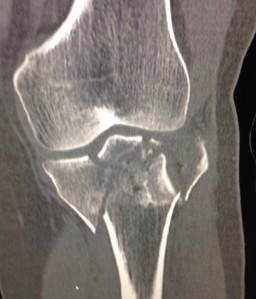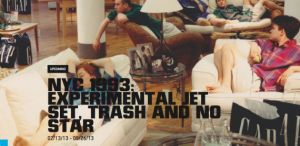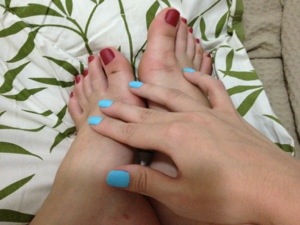
It’s been a long, long while since I last wrote here. The reason I chose today for returning to this place was the commercial launch of the Kate Moss for Topshop collection. I am, with pride, the owner of the beautiful and chic black striped pajama-like ensemble.
It began when I received, a few days ago, a reminder from Net-a-Porter that they’d be selling the collection on their website. I’m not a wild Kate Moss fan–must say never quite understood the frenzy around her–but I figured, hey, Kate Moss wears maxis. I need maxi dresses and Topshop has them in affordable versions. I’ll check the collection out.
Turns out the maxis were not quite affordable (as in for their price I can get designs in which I’m more interested and that are not made of polyester) but the pajama-pantsuit was, and I fell in love with it. And I need pants, too, because I broke my leg, had two surgical interventions in my knee in the course of one month, and that resulted in three very large scars that are far from healed, as well as in a leg that has severely lost muscular mass due to the lack of walking (required for the bone to heal in the right position).
I don’t want to become self-conscious about my scars, although I am, a little; this is, however, a fight I’m willing to win. At the same time, my leg (left one) is healing and weak, the scars must be protected from the sun in order to become as invisible as possible, and this process of “aesthetic” recovery (which in the case of regaining muscles is even more important in terms of rehabilitating the leg for walking) will take a long time, a time during which I still want to feel comfortable and beautiful and not psyched about my scars being exposed to sunlight.
I even purchased make-up for the scars. There are many options and I chose strong concealers from M.A.C., which the saleslady assured me were used for hiding tattoos. They work well, except the powder they sold me to settle the concealer changes its color, and not wearing powder at all implies into having to retouch the concealer all the time. The concealer solution might be interesting at night, but for daylight, I’ll stick with pants and maxis. And tea-lengths. Those are O.K., too. Anyway, I wear a lot of sunscreen on my scars–fabric doesn’t necessarily block UV rays. There are also some interesting, effective treatments: Medgel smoothens the scars, while Accutape makes them more flexible, also improving their appearance. Anything much different then that should be a decision taken at least 8 months after the surgery. That’s the minimum amount of time required for evaluating how a scar will look when “settled,” so to speak.
I’m also very lucky that sneakers and flats couldn’t be more in season. I’m having to basically rebuild my shoe closet, shamefully packed with the highest possible heels, which I’d use every day to go to work. What was I doing with my back and knees, anyways?
A tibial plateau fracture–TPF for the acquainted–is a very serious injury. It hurts like hell and it must be treated by experts and with extreme caution. If you had one and fell upon my blog while researching the injury, my Schatzker classification was V (a bycondilar fracture–aka almost the worst possible shit that can happen to your knee). I had to do two surgeries because the first one, done in an emergency regimen right in the day of the accident, resulted in the shape of my leg being completely altered. The surgeon convinced us that was the best he could do: there was not enough bone material to keep the leg aligned, he said. The hospital was at the base of a packed-up ski resort and I had absolutely no reason to believe a traumatologist that performed surgeries in broken legs and knees for a living had simply done a poor job.
But he had. And when I got a second opinion about the surgery, the first thing the new orthopedist told me when he saw the shape of my leg was that it was simply absurd. He insisted I’d get a new surgery with a traumatologist he trusted. I hadn’t chosen the doctor who performed my first surgery. He was appointed by the hospital, and I simply trusted the system. As for this new orthopedist and the traumatologist he recommended, I made through research regarding their work, credentials, and satisfaction from their patients. I wanted my leg to be straight again, and the new traumatologist told me he could do it. I figured I had little to lose. And I was lucky to believe in him. He fixed my leg, the cost being the new scars, for he used a method that was different from the one adopted by the first surgeon. So here’s one thing that’s important: you need an excellent surgeon, and if the result of your surgery wasn’t excellent, look for someone else. I talked to the first surgeon about having a second surgery, and although he provided all the information I needed for the second surgery to be performed, he was of the opinion that truly, nothing more could be done for my leg. I’m just glad I didn’t hear him.
Researching TPF, I discovered many things that helped me in my own healing process. The first one was that it’s great to be able to keep up good spirits. Most of the (useful) information available on the net about TPFs is hidden in forums dedicated to the subject, and it’s sad–almost contagious–to see how people get depressed about their injury, even if they’re getting amazing results from physiotherapy. Just don’t be depressed. Really. Focus on enjoying the time you’re taking off your daily routine to meditate, read, and most importantly, work your ass off towards healing. Spend many hours of your day exercising your range of movement while you still not allowed partial weight bearing. Exercise your abdomen, your arms and back as well. Try as much as you can to keep your thigh alive. Move your ankles like there’s no tomorrow. Elongate yourself like a mad person. And bend that knee. Defy your pain within your limits, and BEND THAT KNEE.
My first surgeon–who apparently did everything wrong–also kept my leg practically immobilized, and didn’t place any emphasis in me bending my knee. The second doctor I saw was horrified by the fact that almost a month after the surgery, I still wasn’t bending my knee. After the second surgery, I was bending 90 degrees three days after getting back home, and recovering full range of motion became an obsession. One that was well worth it: in three months I’ve already gotten there, and if you do your research, you’ll know that’s rare even after years have passed by. I’m talking FULL range of motion, heels touching my butt range of motion.
Yoga helps if you’ve been into it for a long time. It helped me a lot. I am now into my second week of weight bearing, and yoga has been helping me regain balance and strength, as well as aspects of flexibility that are not easily worked with physiotherapy. Don’t even think of going there if you have no experience with it.
Start physiotherapy as soon as you can. I had at first the idea that I could recover all by myself, but I hired a physiotherapist anyway to see what he could do differently. IT MAKES A DIFFERENCE IF YOU FIND A GOOD ONE. My physiotherapist was able to massage my scars, ankles, calf and thigh muscles and knee in a way that turned my work towards regaining range of motion far more fruitful. There’s lots of loosening up to do in such a severely injured leg and a pro will help you a lot. Hidrotherapy has been really nice, too, and especially now that I’m weight bearing: there are exercises I can do in the water that I still can’t do outside, and those (such as climbing steps) are very effective towards strengthening the injured leg. Again, finding a great professional matters. And if you’ve hired a therapist that’s not making a difference, look for someone else. Don’t give in. You’ve just not found the right person. But always remember: YOUR work is the most important. Think at least four hours a day dedicated to working out, at least 3 of them focusing on your leg.
You can’t gain weight anymore, so don’t lose it as you stay sitting on your ass at home all day. What I did was a lean protein and vegetable based diet. Dark greens like kale, spinach and broccoli are great sources of things you need when healing bones, and lean protein is, well, lean. This should at least help you with not putting on weight. I wouldn’t be optimistic about being able to lose weight during the first three to four months, though, unless you find the strength to dive into a really strict diet. After that time you’ll slowly be able to exercise normally again, so if you think you need to get rid of some fat, start working more strongly on it when you are a couple of weeks into weight bearing.
It may be that you won’t be able to not work for a period of time as long as 3 to 4 months. If this is true, the first advice I give you is: be extremely cautious about your comings and goings. Don’t put yourself in a position that might lead you to be bumped on, for instance, or lose balance. If possible, rent a wheelchair. The second advice is: don’t leave your healing to time and chance. The most important thing you have to do is recover your body. So if you have to work, you have to exercise your leg too. You MUST do both. If possible, think of ways of doing some exercise at work, like bending the knee as much as you can while sitting on your desk.
There will be a lot of swelling in the beginning, and a physiotherapist may help you with that too. Movement is paramount for stopping the swelling, particularly moving the ankles. Did I say already “move your ankles like there’s no tomorrow?” Do it. It’s good for your whole body. Seriously. The ankles are THAT responsible for your wellbeing.
Finally, accept ALL the help. You may even find ways of not needing it, but it will make your life so much better. It was nice to have help with lunch, house cleaning, showering (you don’t want to slip). It was nice to have massages being offered and family to make sure I had everything I needed, because it is difficult to carry things around when both your hands are in charge of moving your body. And when you wake up at night for whatever reason and you’re dizzy and still familiarizing with the crutches, you just feel safer to have someone by your side.
If you have any questions about TPF, you’re welcome to leave them in the comments box. However, if you’d like to know how I liked my Kate Moss for Topshop ensemble, I’ll let you know in a few days. 🙂










